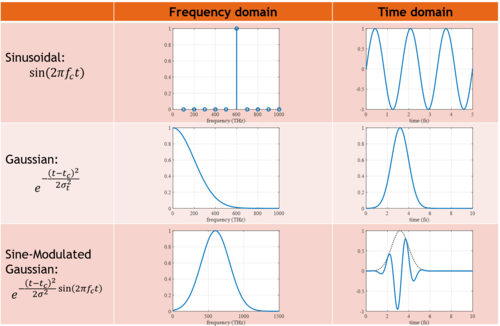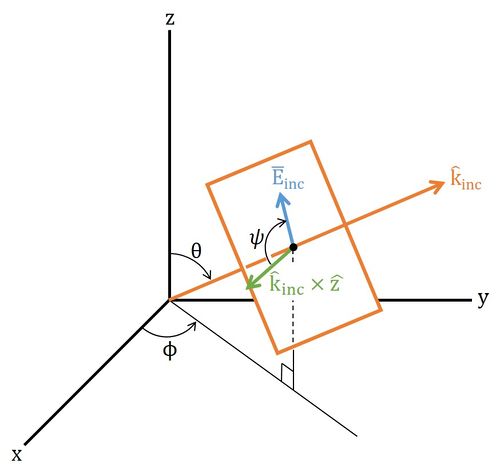"$SourceType" 修訂間的差異
出自 DDCC TCAD TOOL Manual
(→Format) |
|||
| (未顯示同一使用者於中間所作的 8 次修訂) | |||
| 行 1: | 行 1: | ||
=='''Format'''== |
=='''Format'''== |
||
$SourceType |
$SourceType |
||
| − | + | type axis dir θ φ ψ <font color=green>// ''type'', ''axis'', and ''dir'' are integers, the others are floating.</font> |
|
| + | |||
<font size=3> |
<font size=3> |
||
| − | type 1~ |
+ | <span style="color:blue">'''type'''</span>: 1~4 dual wave: sin, exp, sin*exp, multi-sine; |
| + | 11~14 one dir.: sin, exp, sin*exp, multi-sine; |
||
| + | 21~24 TF/SF |
||
| + | 31~34 cuboid source (<span style="color:red">not finished</span>) |
||
| + | 51~54 point source (hard source) |
||
| + | 61~64 point source (soft source) |
||
| + | |||
| + | <span style="color:blue">'''axis'''</span>: 1~3 represents the source is along x, y, or z axis.<br> |
||
| + | ''p.s.1'' it is useless for TF/SF source. |
||
| + | ''p.s.2'' for point source, axis means the direction of dipole. |
||
| − | the unit of theta and phi is degree, it will be changed to radians. |
||
| + | <span style="color:blue">'''dir'''</span>: -1 means the wave goes to negative, |
||
| + | 1 means the wave goes to positive.<br> |
||
| + | ''p.s.'' it is useless for TF/SF and point source. |
||
| − | As type<20, theta is the polarized angle. |
||
| + | <span style="color:blue">'''θ''', '''φ''', '''ψ'''</span>: the unit is degree and will be changed to radian in the program. |
||
| + | θ is relative to the +z-axis of the space lattice, 0° ≤ θ <180°. |
||
| + | φ is relative to the +x-axis of the lattice, 0° ≤ φ < 360°. |
||
| + | ψ is relative to the direction <math>\hat{\mathbf{k}}_{inc} \times \hat{\mathbf{z}}</math>, 0° ≤ ψ < 360°. (polarization angle) |
||
| + | [[File: Source_type.png|source types in frequency and time domain.|left|thumb|500px]] <br> |
||
| + | [[File: Source_angle.jpg|The meaning of theta, phi, and psi.|left|thumb|500px]] |
||
| + | <br><br><br><br><br><br><br><br><br><br><br><br><br><br><br><br><br><br><br><br><br><br> |
||
| + | <br><br><br><br><br><br><br><br><br><br><br><br><br> |
||
</font> |
</font> |
||
=='''Example'''== |
=='''Example'''== |
||
$SourceType |
$SourceType |
||
| − | 12 3 -1 0 0 |
+ | 12 3 -1 0 0 0 |
== '''Related commands''' == |
== '''Related commands''' == |
||
| − | : [[$SourcePosition]], [[$SourceFrequency]] |
+ | : [[$SourceType]], [[$SourceAmp]], [[$SourcePosition]], [[$SourceFrequency]] |
於 2021年2月25日 (四) 10:54 的最新修訂
Format
$SourceType type axis dir θ φ ψ // type, axis, and dir are integers, the others are floating.
type: 1~4 dual wave: sin, exp, sin*exp, multi-sine; 11~14 one dir.: sin, exp, sin*exp, multi-sine; 21~24 TF/SF 31~34 cuboid source (not finished) 51~54 point source (hard source) 61~64 point source (soft source)
axis: 1~3 represents the source is along x, y, or z axis.
p.s.1 it is useless for TF/SF source. p.s.2 for point source, axis means the direction of dipole.
dir: -1 means the wave goes to negative, 1 means the wave goes to positive.
p.s. it is useless for TF/SF and point source.
θ, φ, ψ: the unit is degree and will be changed to radian in the program. θ is relative to the +z-axis of the space lattice, 0° ≤ θ <180°. φ is relative to the +x-axis of the lattice, 0° ≤ φ < 360°. ψ is relative to the direction, 0° ≤ ψ < 360°. (polarization angle)
Example
$SourceType 12 3 -1 0 0 0
Related commands
- $SourceType, $SourceAmp, $SourcePosition, $SourceFrequency

